Machinability Research on the Micro-Milling for Graphene Nano-Flakes Reinforced Aluminum Alloy
Abstract
:1. Introduction
2. Material Manufacture and Characterization
2.1. Aluminum Microparticles and Graphene Nano-Platelets
2.2. Composites Characterization
3. Micro-Milling Experiment Setup
3.1. Workpieces and Experiment Platform
3.2. Process Parameters
4. Experimental Results and Discussions
4.1. Milling Forces with Different Feed Per Tooth
4.2. Milling Forces with Different GNFs/Al Composites
4.3. Chip Morphology
4.4. Surface Integrity
5. Conclusions
- (1)
- The addition of graphene of GNFs/Al composites has grain refinement, lubrication and agglomeration effect. When the content of graphene is less than 1.0%, the grain refinement of graphene is dominant, which improves the density and hardness of the material. When the content of graphene is higher than 1.5%, the agglomeration effect of graphene occurs, which reduces the density and hardness of the material. At the same time, when the graphene content is 1%, the milling force reaches a peak value because of the dominant role of grain refinement.
- (2)
- It was observed from microscopic image that curling degree of chips increased as FPT increase, which begins as a crack chip at lower FPT and then serrated chip and finally continuous chip with higher FPT. This is due to that chip formation is mainly affected by friction and shear force between tool and workpiece during micro-milling process. At same time, as the graphene content of composites increase, the chip formation changes also from crack morphology to continuous ones under same FPT condition.
- (3)
- The surface roughness results showed that influence of FTP on surface roughness is similar to that of milling force. At same time, when the content of graphene in composites is higher than 1%, the surface roughness of milling grooves is greatly improved, which may be related to the lubrication of graphene and the continuity of chips.
Author Contributions
Funding
Conflicts of Interest
References
- Bastwros, M.; Kim, G.Y.; Zhu, C.; Zhang, K.; Wang, S.; Tang, X.; Wang, X. Effect of ball milling on graphene reinforced Al6061 composite fabricated by semi-solid sintering. Compos. Part B 2014, 60, 111–118. [Google Scholar] [CrossRef]
- Agarwal, A.; Rao, B.S.; Lahiri, D. Carbon Nanotubes: Reinforced Metal Matrix Composites; CRC Press: Boca Raton, FL, USA, 2010. [Google Scholar]
- Kuruc, M.; Šimna, V.; Necpal, M.; Vopát, T.; Peterka, J. Influence of ultrasound on delamination during machining of GFRP composite material. Solid State Phenom. 2017, 261, 173–178. [Google Scholar] [CrossRef]
- Podymova, N.B.; Karabutov, A.A. Combined effects of reinforcement fraction and porosity on ultrasonic velocity in SiC particulate aluminum alloy matrix composites. Compos. Part B 2017, 113, 138–143. [Google Scholar] [CrossRef]
- Selvakumar, S.; Dinaharan, I.; Palanivel, R.; GaneshBabu, B. Development of stainless steel particulate reinforced AA6082 aluminum matrix composites with enhanced ductility using friction stir processing. Mater. Sci. Eng. A 2017, 685, 317–326. [Google Scholar] [CrossRef]
- Tian, K.; Zhao, Y.; Lei, J.; Zhang, S.; Zhang, Z.; Wu, X. Effects of in situ generated ZrB2 nano-particles on microstructure and tensile properties of 2024Al matrix composites. J. Alloys Compd. 2014, 594, 1–6. [Google Scholar] [CrossRef]
- Min, S.; He, Y.; Fang, S. Yield stress of SiC reinforced aluminum alloy composites. J. Mater. Sci. 2010, 45, 4097–4110. [Google Scholar]
- Pierard, N.; Fonseca, A.; Colomer, J.F.; Bossuot, C.; Benoit, J.-M.; Tendeloo, G.V.; Pirard, J.-P.; Nagy, J.B. Ball milling effect on the structure of single-wall carbon nanotubes. Carbon 2004, 42, 1691–1697. [Google Scholar] [CrossRef]
- Chao, S.; Min, S.; Wang, Z.; He, Y. Effect of particle size on the microstructures and mechanical properties of SiC-reinforced pure aluminum composites. J. Mater. Eng. Perform. 2011, 20, 1606–1612. [Google Scholar]
- Topcu, I.; Gulsoy, H.O.; Kadioglu, N.; Gulluoglu, A.N. Processing and mechanical properties of B4C reinforced Al matrix composites. J. Alloys Compd. 2009, 482, 516–521. [Google Scholar] [CrossRef]
- Soon-Jik, H.; Hong-Moule, K.; Huh, D.; Suryanarayana, C.; SunChun, B. Effect of clustering on the mechanical properties of SiC particulate-reinforced aluminum alloy 2024 metal matrix composites. Mater. Sci. Eng. A 2003, 347, 198–204. [Google Scholar]
- Chawla, N.; Shen, Y.L. Mechanical behavior of particle reinforced metal matrix composites. Adv. Eng. Mater. 2001, 3, 357–370. [Google Scholar] [CrossRef]
- Moghadam, A.D.; Omrani, E.; Menezes, P.L.; Rohatgi, P.K. Mechanical and tribological properties of self-lubricating metal matrix nanocomposites reinforced by carbon nanotubes (CNTs) andgraphene—A review. Compos. Part B 2015, 77, 402–420. [Google Scholar] [CrossRef]
- Stankovich, S.; Dikin, D.A.; Dommett, G.H.B.; Kohlhaas, K.M.; Zimney, E.J.; Stach, E.A.; Piner, R.D.; Nguyen, S.T.; Ruoff, R.S. Graphene-based composite materials. Nature 2006, 442, 282–286. [Google Scholar] [CrossRef] [PubMed]
- Tjong, S.C. Recent progress in the development and properties of novel metal matrix nanocomposites reinforced with carbon nanotubes and graphene nanosheets. Mater. Sci. Eng. R Rep. 2013, 74, 281–350. [Google Scholar] [CrossRef]
- Rashad, M.; Pan, F.; Tang, A.; Lu, Y.; Asif, M.; Hussain, S.; She, J.; Gou, J.; Mao, J. Effect of graphene nanoplatelets (GNPs) addition on strength and ductility of magnesium-titanium alloys. J. Magne. Alloys 2013, 1, 242–248. [Google Scholar] [CrossRef] [Green Version]
- Wang, T.; Zou, C.; Chen, Z.; Li, M.; Wang, W.; Li, R.; Kang, H. In situ synthesis of TiB2 particulate reinforced copper matrix composite with a rotating magnetic field. Mater. Des. 2015, 65, 280–288. [Google Scholar] [CrossRef]
- Han, B.; Yang, Z.; Shi, X.; Yu, X. Transport properties of carbon-nanotube/cement composites. J. Mater. Eng. Perform. 2013, 22, 184–189. [Google Scholar] [CrossRef]
- El-Ghazaly, A.; Anis, G.; Salem, H.G. Effect of graphene addition on the mechanical and tribological behavior of nanostructured AA2124 self-lubricating metal matrix composite. Compos. Part A 2017, 95, 325–336. [Google Scholar] [CrossRef]
- Li, J.L.; Xiong, Y.C.; Wang, X.D.; Yan, S.J.; Yang, C.; He, W.W.; Chen, J.Z.; Wang, S.Q.; Zhang, X.Y.; Dai, S.L. Microstructure and tensile properties of bulk nanostructured aluminum/graphene composites prepared via cryomilling. Mater. Sci. Eng. A 2015, 626, 400–405. [Google Scholar] [CrossRef]
- Shin, S.E.; Choi, H.J.; Shin, J.H.; Bae, D.H. Strengthening behavior of few-layered graphene/aluminum composites. Carbon 2015, 82, 143–151. [Google Scholar] [CrossRef]
- Yan, S.J.; Dai, S.L.; Zhang, X.Y.; Yang, C.; Hong, Q.H.; Chen, J.Z. Investigating aluminum alloy reinforced by graphene nanoflakes. Mater. Sci. Eng. A 2014, 612, 440–444. [Google Scholar] [CrossRef]
- Di Ilio, A.; Paoletti, A. Machinability aspects of metal matrix composites. In Machining of Metal Matrix Composites; Springer: London, UK, 2012; pp. 63–77. [Google Scholar]
- Manna, A.; Bhattacharayya, B. A study on machinability of Al/SiC-MMC. J. Mater. Process. Technol. 2003, 140, 711–716. [Google Scholar] [CrossRef]
- Samuel, J.; DeVor, R.E.; Kapoor, S.G.; Hsia, K.J. Experimental investigation of the machinability of polycarbonate reinforced with multiwalled carbon nanotubes. J. Manuf. Sci. Eng. 2015, 128, 465–473. [Google Scholar] [CrossRef]
- Samuel, J.; Dikshit, A.; DeVor, R.E.; Kapoor, S.G.; Hsia, K.J. Effect of carbon nanotube (CNT) loading on the thermo-mechanical properties and the machinability of CNT-reinforced polymer composites. J. Manuf. Sci. Eng. 2008, 131, 203–213. [Google Scholar]
- Ghai, I.; Samuel, J.; Devor, R.E.; Kapoor, S.G. Effect of carbon nanotube loading on the machinability of polycarbonate nanocomposites. J. Mech. Eng. Mater. Sci. 2007, 1, 75–84. [Google Scholar]
- Dikshit, A.; Samuel, J.; DeVor, R.E.; Kapoor, S.G. Microstructure-level machining simulation of carbon nanotube reinforced polymer composites—Part II: Model interpretation and application. J. Manuf. Sci. Eng. 2008, 130, 031115. [Google Scholar] [CrossRef]
- Arora, I.; Samuel, J.; Koratkar, N. Experimental investigation of the machinability of epoxy reinforced with graphene platelets. J. Manuf. Sci. Eng. 2013, 135, 041007. [Google Scholar] [CrossRef]
- Liu, J.; Cheng, K.; Ding, H.; Chen, S.; Zhao, L. An investigation of surface defect formation in micro milling the 45% sicp/al composite. Procedia CIRP 2016, 45, 211–214. [Google Scholar] [CrossRef]
- Gao, C.; Zhao, X. Factor analysis of machining parameters of SiC nanoparticle-reinforced magnesium matrix composites with consideration of cluster effect. Int. J. Mach. Mach. Mater. 2015, 17, 165. [Google Scholar] [CrossRef]
- Wang, J.; Li, Z.; Fan, G.; Pan, H.; Chen, Z.; Zhang, D. Reinforcement with graphene nanosheets in aluminum matrix composites. Scr. Mater. 2012, 66, 594–597. [Google Scholar] [CrossRef] [Green Version]
- Baig, Z.; Mamat, O.; Mustapha, M. Recent progress on the dispersion and the strengthening effect of carbon nanotubes and graphene-reinforced metal nanocomposites: A Review. Crit. Rev. Solid State Mater. Sci. 2016, 43, 1–46. [Google Scholar] [CrossRef]
- Nieto, A.; Bisht, A.; Lahiri, D.; Zhang, C.; Agarwal, A. Graphene reinforced metal and ceramic matrix composites: A review. Metall. Rev. 2016, 62, 241–302. [Google Scholar] [CrossRef]
- Malekian, M.; Mostofa, M.G.; Park, S.S.; Jun, M.B.G. Modeling of minimum uncut chip thickness in micro machining of aluminum. J. Mater. Process. Technol. 2011, 212, 553–559. [Google Scholar] [CrossRef]
- Son, S.M.; Hanm, S.L.; Ahn, J.H. Effects of the friction coefficient on the minimum cutting thickness in micro cutting. Int. J. Mach. Tools Manuf. 2005, 45, 529–535. [Google Scholar] [CrossRef]
- Barabasi, A.L.; Stanley, H.E. Fractal Concepts in Surface Growth; Press Syndicate of the University of Cambridge: Cambridge, UK, 1995. [Google Scholar]
- Kumar, M.N.; Mahmoodi, M.; Tabkhpaz, M.; Park, S.S.; Jin, X. Characterization and micro end milling of graphene nano platelet and carbon nanotube filled nanocomposites. J. Mater. Process. Technol. 2017, 249, 96–107. [Google Scholar] [CrossRef]
- Rafiee, M.A.; Rafiee, J.; Srivastava, I.; Wang, Z.; Song, H.; Yu, Z.-Z.; Koratkar, N. Fracture and fatigue in graphene nanocomposites. Small 2010, 6, 179–183. [Google Scholar] [CrossRef]
- Rafiee, M.A.; Rafiee, J.; Yu, Z.-Z.; Koratkar, N. Buckling resistant graphene nanocomposites. Appl. Phys. Lett. 2009, 95, 223103. [Google Scholar] [CrossRef]
- Rafiee, M.A.; Rafiee, J.; Wang, Z.; Song, H.; Yu, Z.-Z.; Koratkar, N. Enhanced mechanical properties of nanocomposites at low graphene content. ACS Nano 2009, 3, 3884–3890. [Google Scholar] [CrossRef]

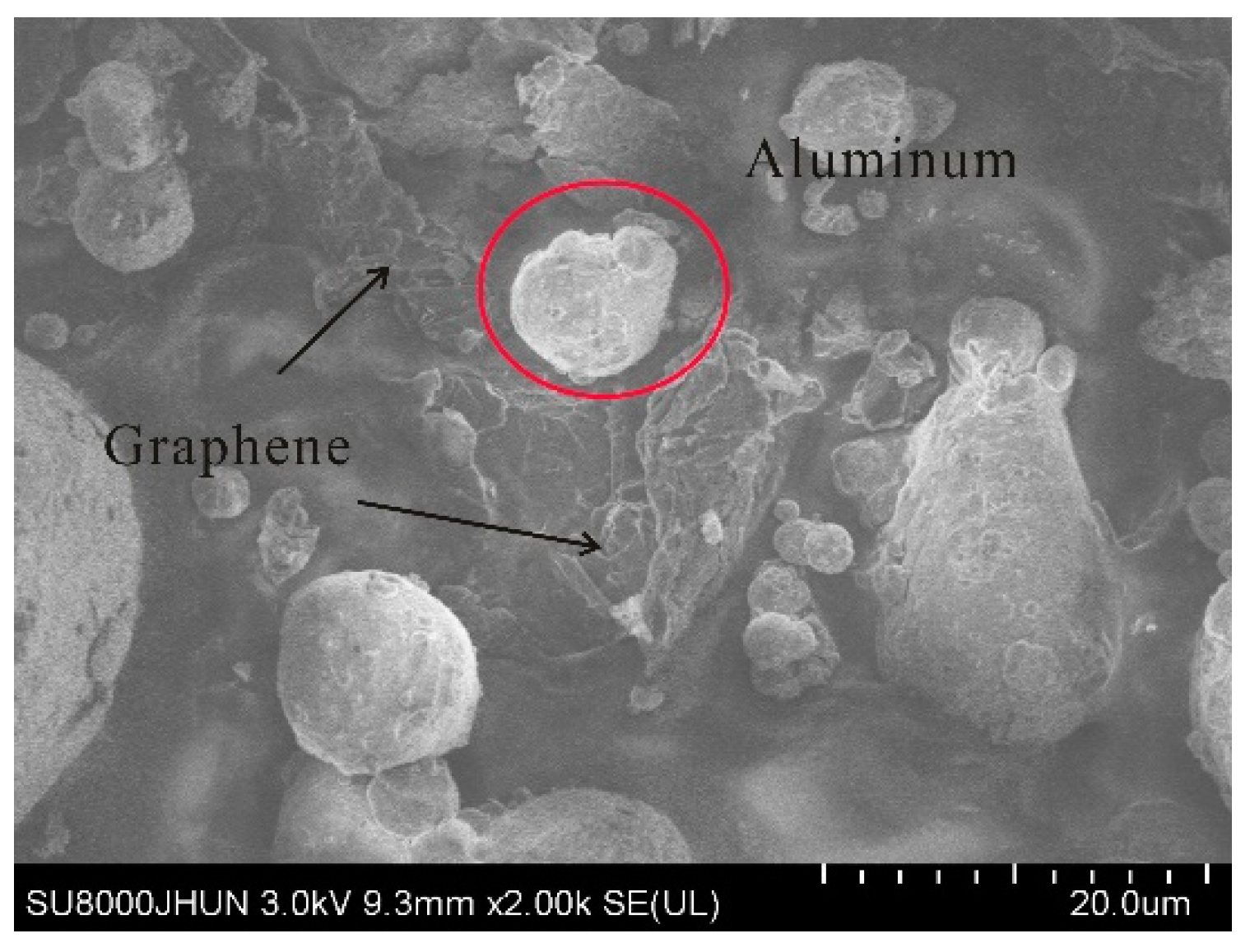

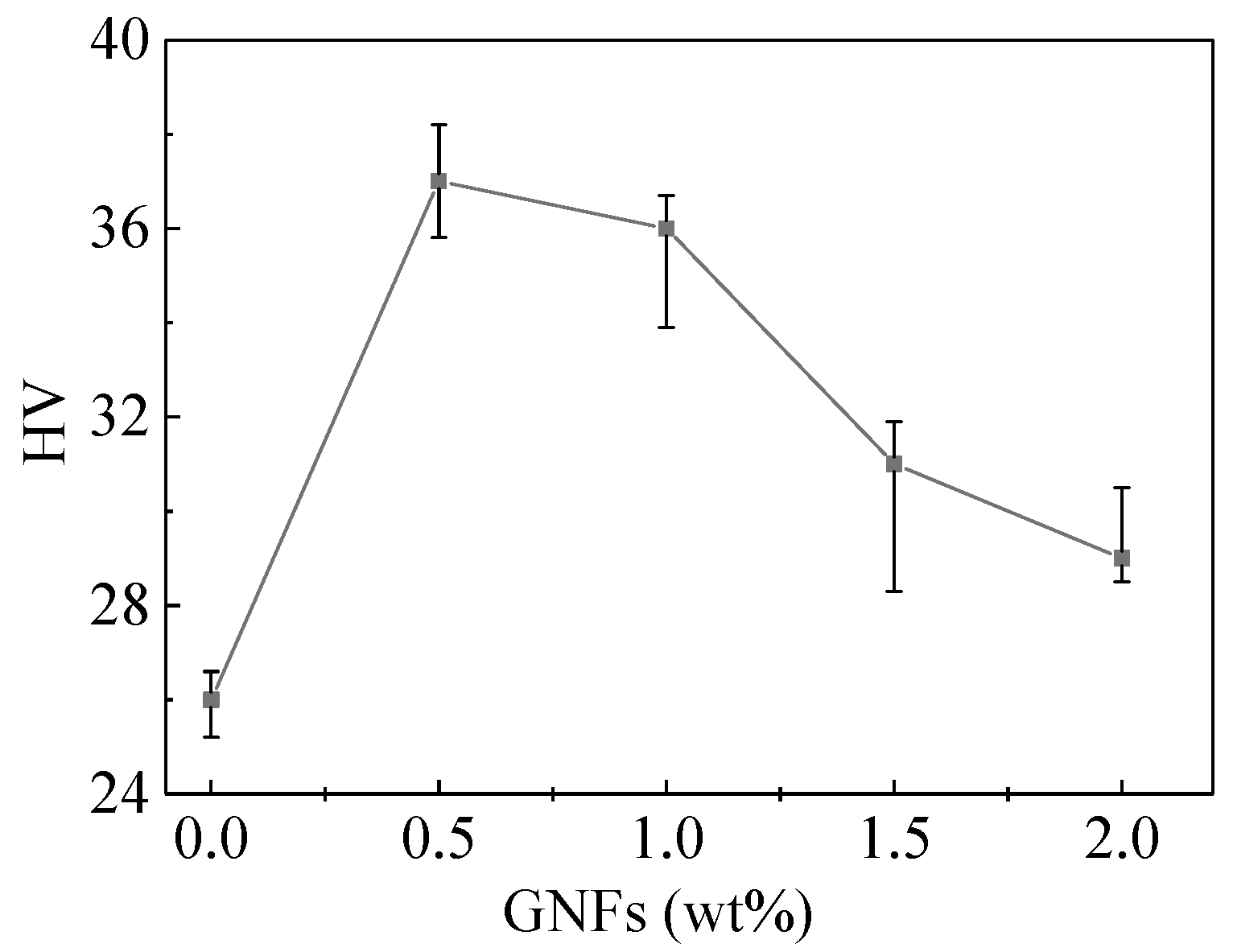
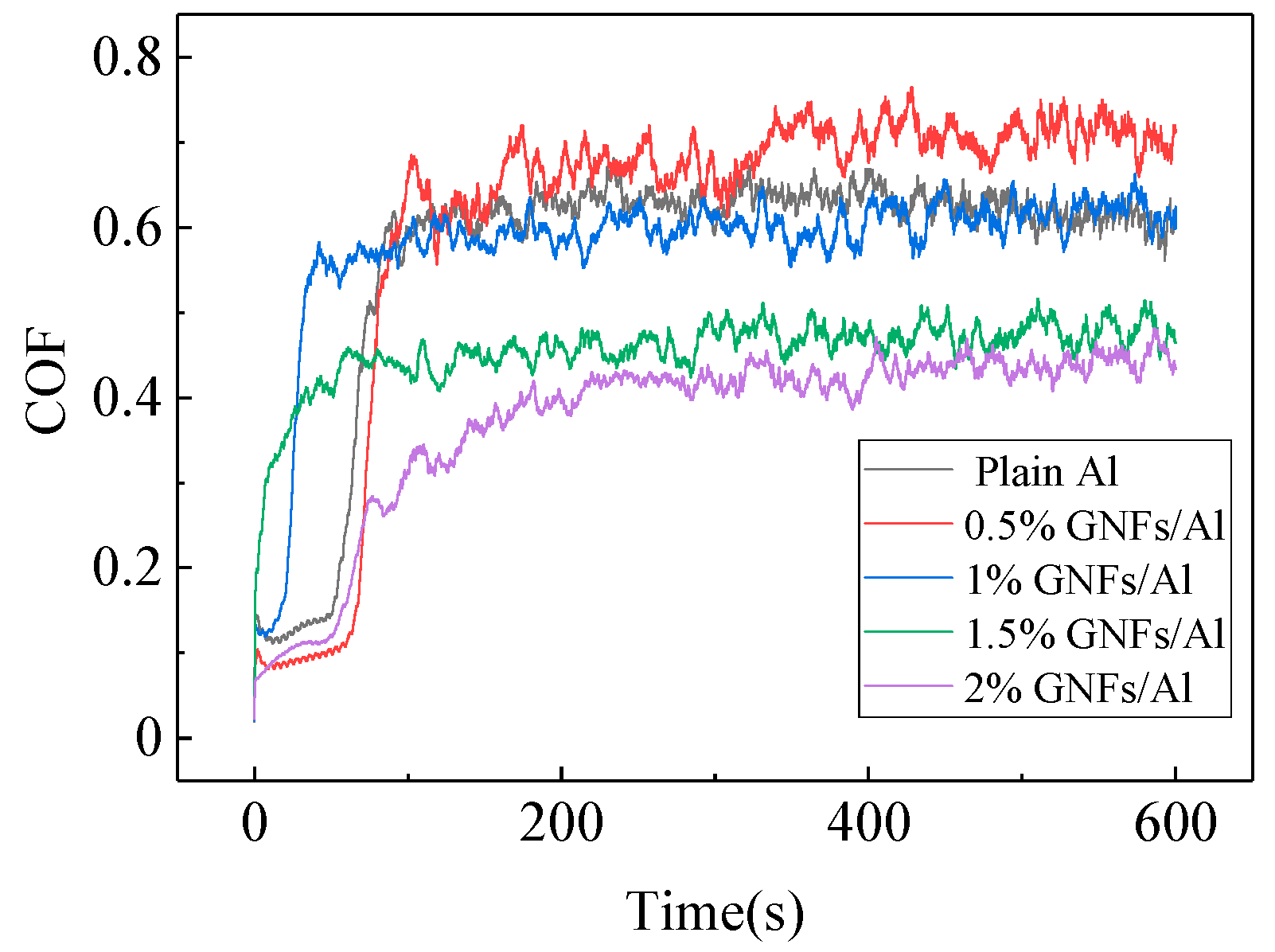
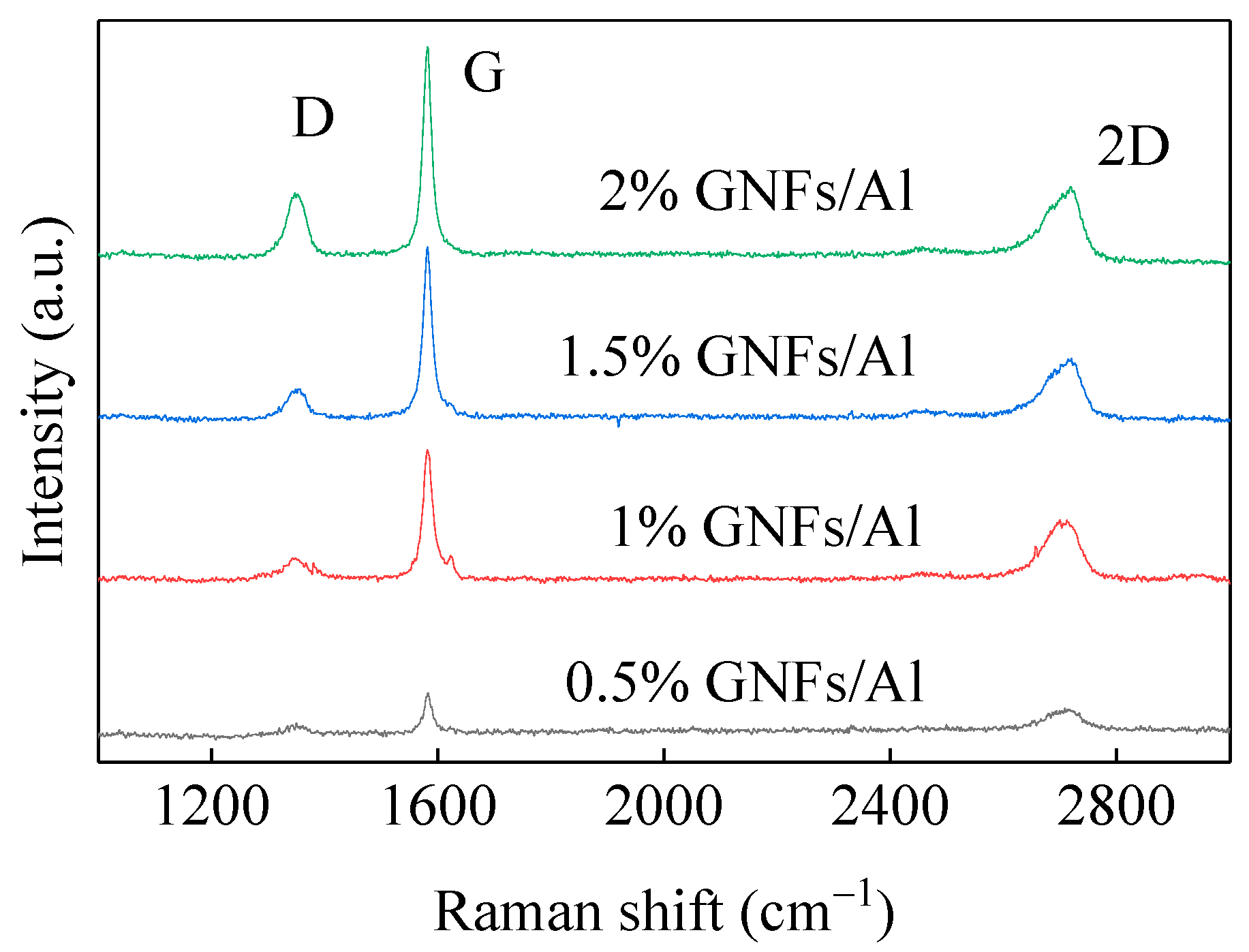
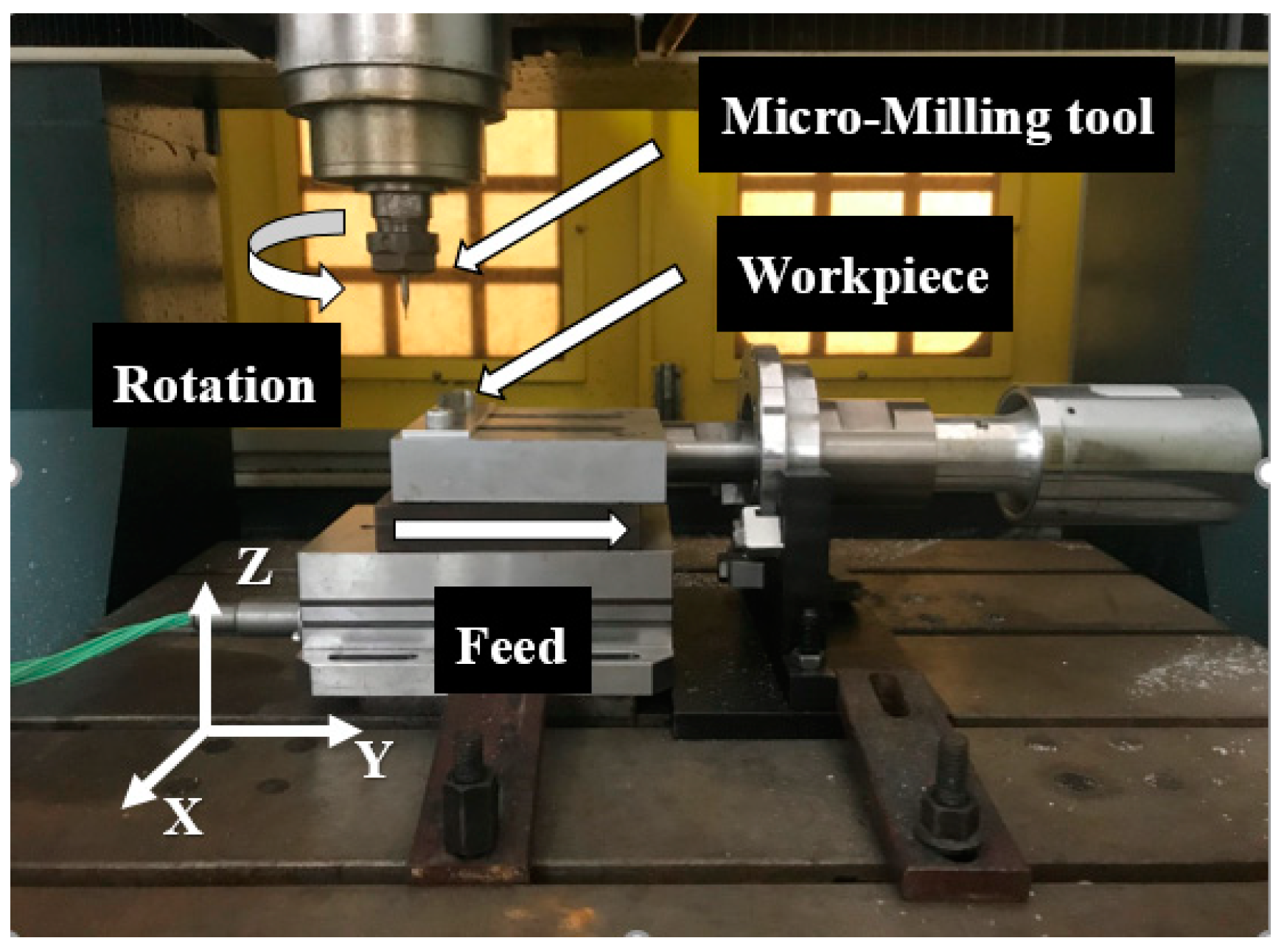
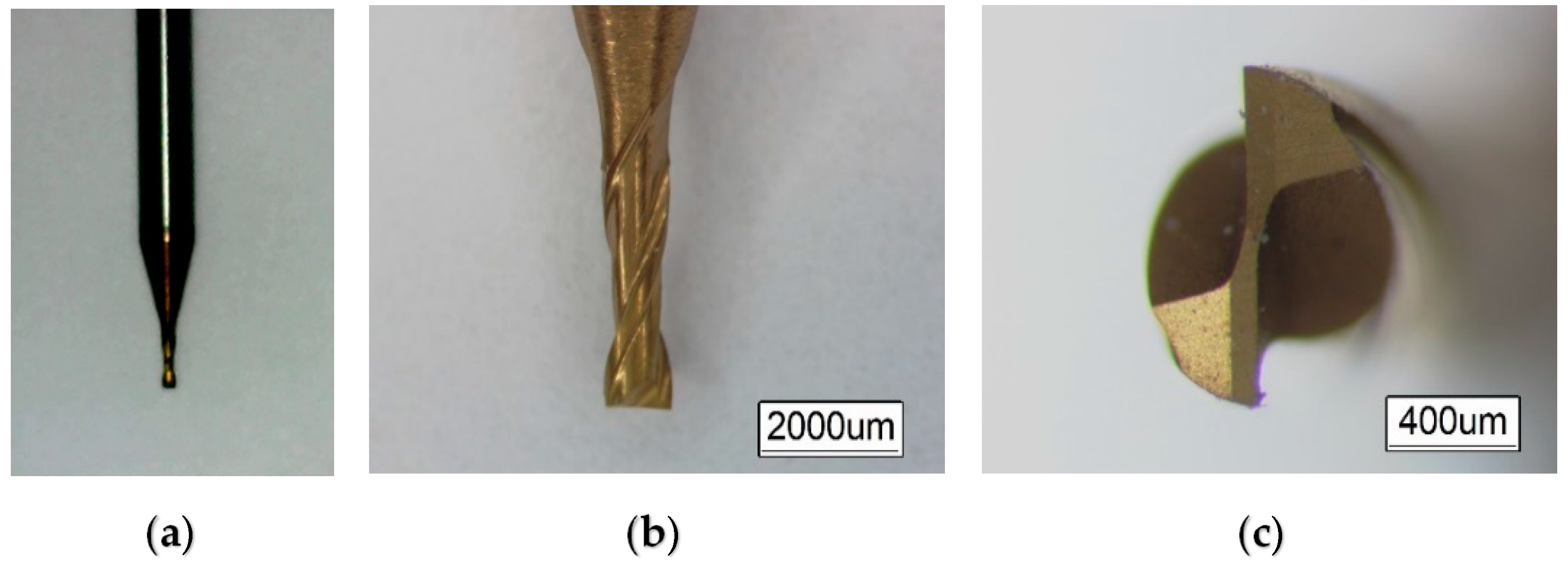
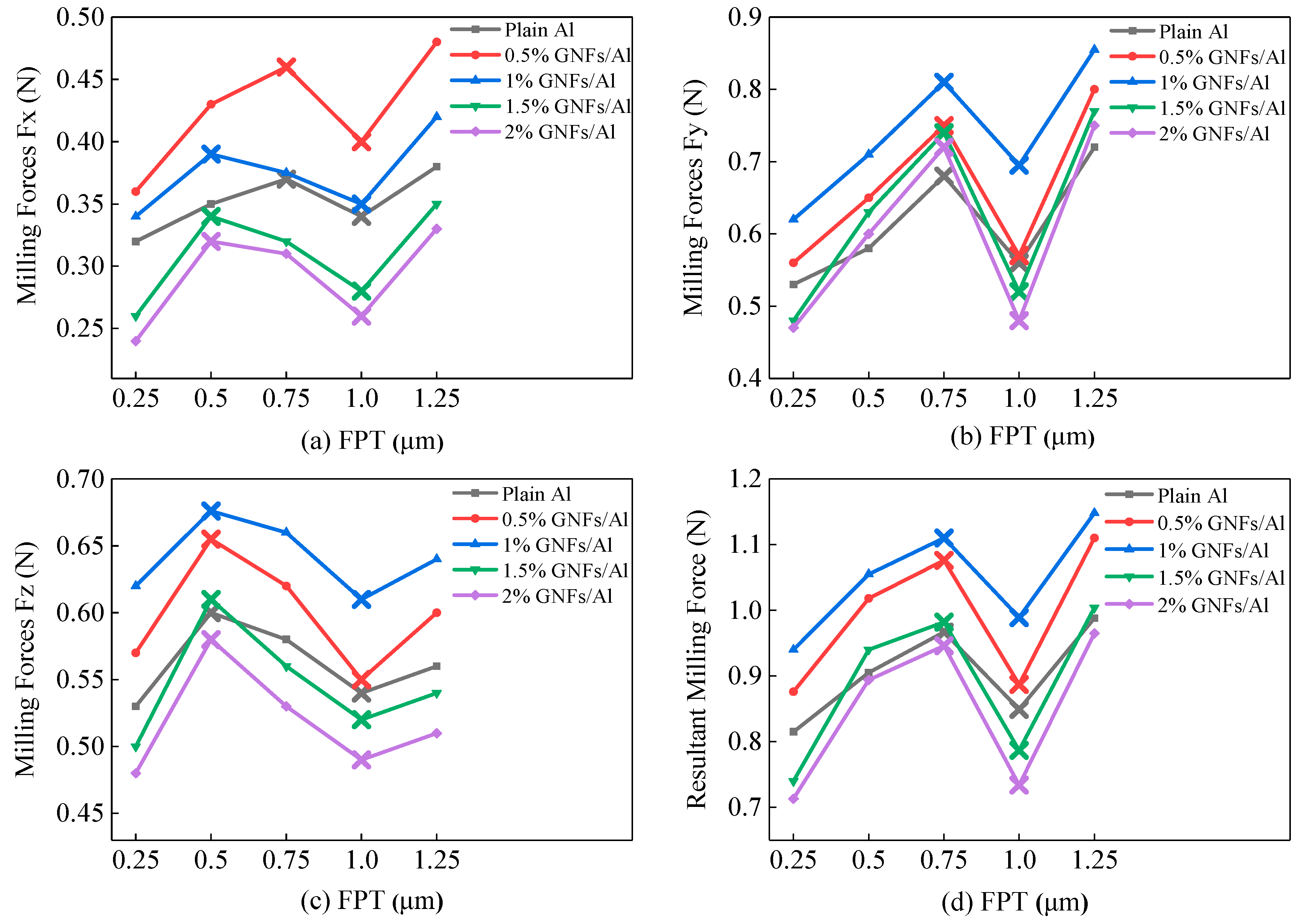


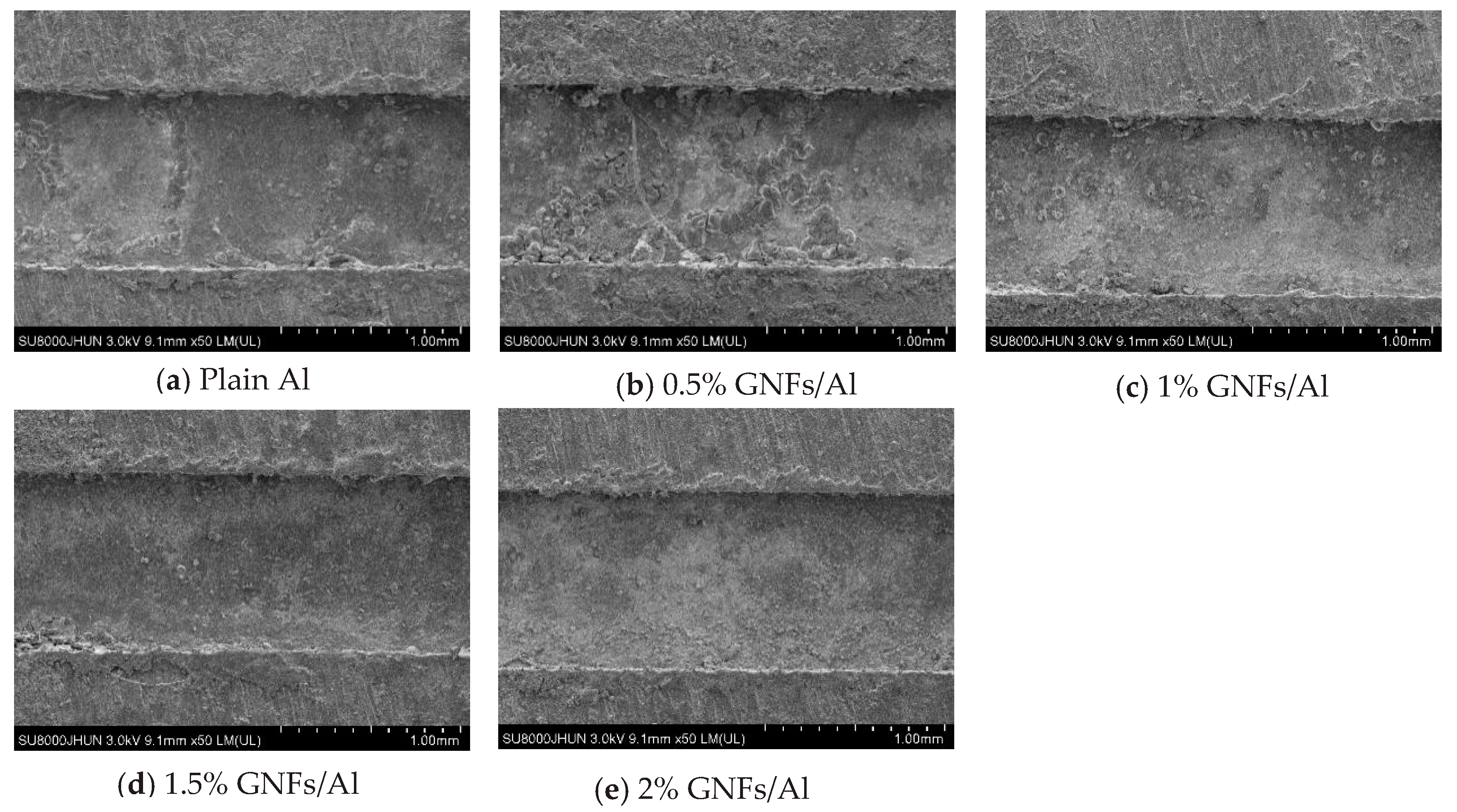
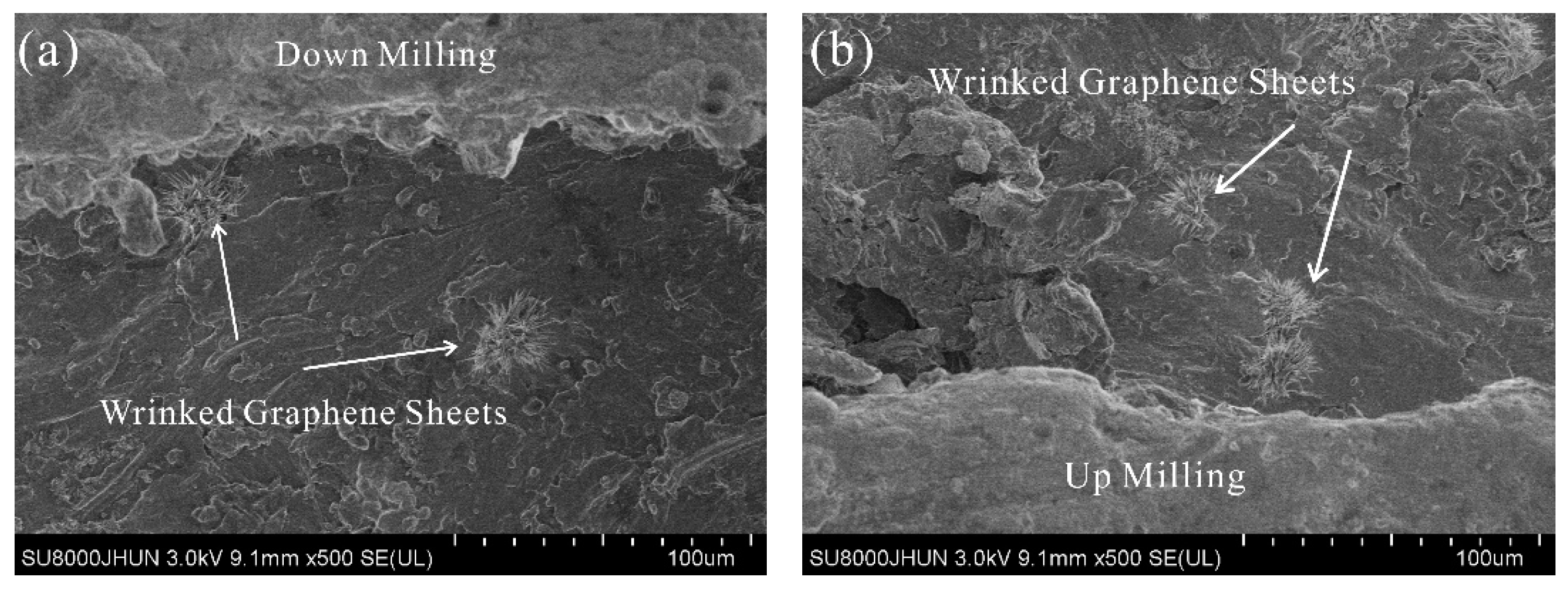
| Samples | Actual Density | Theoretical Density | Relative Density | HV | Grain Size |
|---|---|---|---|---|---|
| Plain Al | 2.68 | 2.7 | 99.26% | 26 | 9.21 μm |
| 0.5% GNFs/Al | 2.66 | 2.69 | 98.89% | 37 | 6.78 μm |
| 1.0% GNFs/Al | 2.65 | 2.68 | 98.88% | 36 | 7.66 μm |
| 1.5% GNFs/Al | 2.63 | 2.66 | 98.87% | 31 | 8.12 μm |
| 2.0% GNFs/Al | 2.61 | 2.65 | 98.49% | 29 | 8.37 μm |
| Workpiece | Plain Al Composite with 0.5%, 1%, 1.5% and 2% Loading by Weight of GNFs |
|---|---|
| Tool | Micro end mill with 1 mm diameter, edge radius: 2 μm |
| Spindle speed | 20,000 r/min |
| Axial depth-of-cut | 200 μm |
| Feed per tooth | 0.25, 0.5, 0.75, 1, and 1.25 μm/z |
© 2019 by the authors. Licensee MDPI, Basel, Switzerland. This article is an open access article distributed under the terms and conditions of the Creative Commons Attribution (CC BY) license (http://creativecommons.org/licenses/by/4.0/).
Share and Cite
Na, H.-B.; Xu, L.-H.; Han, G.-C.; Liu, S.-K.; Lu, L.-H. Machinability Research on the Micro-Milling for Graphene Nano-Flakes Reinforced Aluminum Alloy. Metals 2019, 9, 1102. https://doi.org/10.3390/met9101102
Na H-B, Xu L-H, Han G-C, Liu S-K, Lu L-H. Machinability Research on the Micro-Milling for Graphene Nano-Flakes Reinforced Aluminum Alloy. Metals. 2019; 9(10):1102. https://doi.org/10.3390/met9101102
Chicago/Turabian StyleNa, Hao-Bo, Lin-Hong Xu, Guang-Chao Han, Shao-Kang Liu, and Lu-Hua Lu. 2019. "Machinability Research on the Micro-Milling for Graphene Nano-Flakes Reinforced Aluminum Alloy" Metals 9, no. 10: 1102. https://doi.org/10.3390/met9101102





